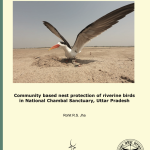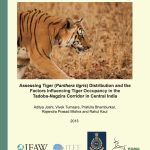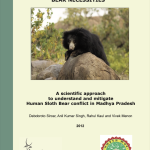38 new Sarus Mitras trained to protect sarus cranes in Uttar Pradesh
Bahraich, 30th Dec, 2014: Wildlife Trust of India (WTI) inducted 38 new Sarus Mitras (Friends of Sarus) in the districts of Siddhartha Nagar and Bahraich this past week. The local volunteers were trained in wetland monitoring, bird species identification, and tracking sarus crane populations, including nest monitoring and reporting sarus crane mortality. WTI partnered with non-governmental organisations including the Swabhiman Seva Samiti, the Narayan Siddharth Seva Trust, and the Aparajita Samajik Sansthan to lead the program.
The Sarus Crane Conservation Project, initiated by the Wildlife Trust of India (WTI) in 2013, has played a pivotal role in safeguarding these iconic birds. Recognised as the tallest flying bird in the world, these cranes stand over five feet tall and symbolise elegance and endurance. However, the species is listed as “Vulnerable” by the IUCN, threatened by habitat loss and human disturbances.

Training of Sarus Mitra volunteers | Photo by WTI
Uttar Pradesh serves as a vital habitat for sarus cranes, but rapid urbanisation and agricultural intensification have forced them to adapt to flooded farmlands, such as rice paddies. Although these fields mimic natural wetlands, they also expose the cranes to threats like habitat degradation, poaching, and accidental harm, especially during the breeding season.
At the heart of the conservation efforts are the Sarus Mitras—dedicated local volunteers serving as stewards of the wetlands. Since the inception, more than 160 Sarus Mitras have joined the cause, diligently protecting crane habitats across ten districts, including Bahraich, Balrampur, Barabanki, Ayodhya (Faizabad), Kushinagar, Maharajganj, Sant Kabir Nagar, Shrawasti, Shahjahanpur, and Siddhartha Nagar. The project has established wetland conservation committees comprising members of the local community. Awareness programs, led by Sarus Mitras, have also encouraged organic farming and reduced pesticide usage, promoting safer breeding environments for the cranes.
The results have been inspiring. Between 2013 and 2024, the crane’s population in project areas rose from 681 to 2,679 individuals. Similarly, the number of nests increased from 40 to 208, highlighting the success of community-driven conservation. Farmers adopting sustainable practices have further enhanced wetland health and nesting safety. The rising population in the project area in Uttar Pradesh exemplifies the impact of grassroots conservation and collective action. Farmlands have transformed into sanctuaries, and farmers have emerged as protectors through awareness, training and shared commitment.

A Sarus Mitra volunteer, monitoring nest at the Chiraiyakot wetland | Photo by Aeshad Hussain/WTI
“The Sarus Mitra model is an inspiring example of human-wildlife coexistence,” said WTI’s Chief Ecologist Dr. Samir Kumar Sinha. “Our approach has been instrumental in building community support and documenting wetlands that are vital for sarus crane conservation”, he adds. This initiative highlights how conservation efforts thrive when communities unite for a shared cause, preserving biodiversity and securing habitats for generations to come.









